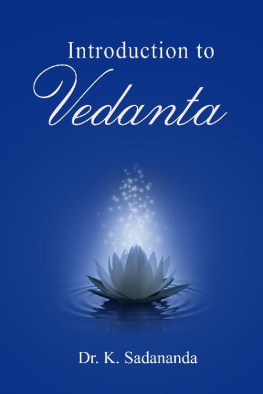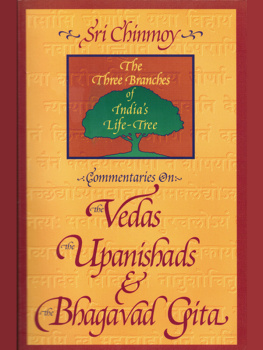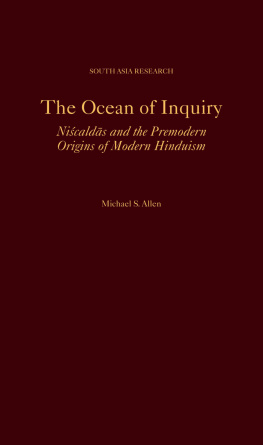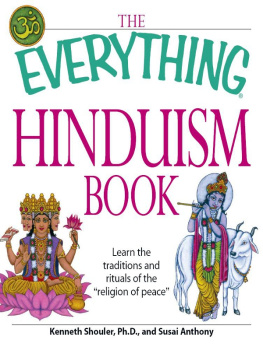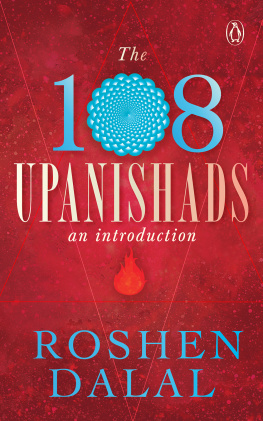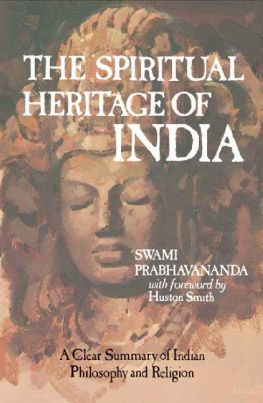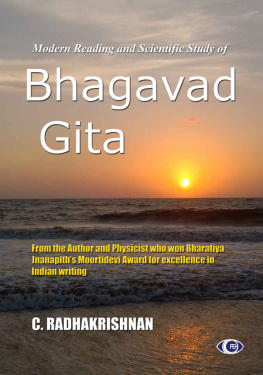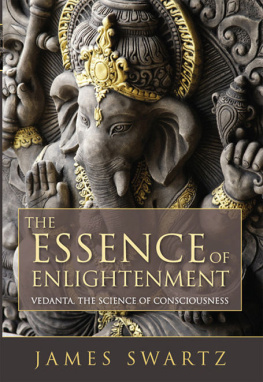Introduction to Vedanta
Dr. K. Sadananda
Edited by Dennis Waite
Introduction to Vedanta
Copyright 2017 by Dr. K. Sadananda
All rights reserved. This book or any portion thereof
may not be reproduced or used in any manner whatsoever
without the express written permission of the publisher or
the author, except for the use of brief quotations in a
book review.
First Edition, 2017
ISBN-13: 978-0-9991704-0-3 Paperback
ISBN-13: 978-0-9991704-2-7 Hardcover
Library of Congress Control Number: 2017947891
Publisher:
srath-visual press
Cedar Rapids, Iowa, 52402
United States
srath@srath-visual.com
Note: Editing for publication has Americanized the original English version. If any errors crept in, it is to be attributed to the publisher and not to the Editor of the original material.
Foreword
I first encountered Dr. Sadananda back around 1994. At that time, I was actively researching Advaita via the Internet (the only source I had at the time) and I found his article Who is the Deep Sleeper I? on the Chinmayananda website. It was so clear and helpful that, eventually, I had to write to him to ask him several questions prompted by the article. Thus began a long association via Internet discussion groups and emails, though we did also meet when he came over to England for a conference.
He is a prolific writer, producing many series of articles and talks on specific topics or scriptures as well as always being available to answer questions posed by seekers. The only problem is that his typing cannot always keep up with his bountiful flow of ideas so that, when I eventually asked if I could publish some of his material on my website (www.advaita.org.uk), to which of course he agreed immediately, I was also obliged to spend significant time editing! But this was to my advantage! The editing process naturally necessitated careful analysis of what had been written, so that it proved an invaluable learning process also! This was especially the case with the series on Knowledge. This is a commentary/elucidation of Vedanta Paribhasa of Dharmaraja Adhvarindra and, quite frankly, the original text is virtually unreadable and extremely difficult to follow. There was simply no way I would ever have followed the original, so Dr. Sadananda having done the principal work already was extremely helpful!
The present series An Introduction to Vedanta was originally serialized on the Advaitin discussion group where it was justifiably well-received. As they say in the advertising media: it does what it says on the box. It covers all of the material needed to introduce the subject to a new seeker, clarifying aspects that could otherwise prove difficult or even dampen enthusiasm. He never talks down to his listeners but speaks directly to them using everyday examples that resonate immediately. No doubt he benefits from having been taught directly by Swami Chinmayananda and more recently by many other teachers including Swami Tejomayananda and Swami Paramarthananda, but his scientific background also brings naturally clear reasoning ability to his analysis of the subject with the result that he seems able to explain the most difficult topics.
Anyone looking for an overview of the essential teaching of Advaita could not do better than to read this Introduction.
Dennis Waite
June 2017
Bournemout h , UK
Preface
This text Introduction to Vedanta took a form when my friend Dennis Waite became a Chief-Moderator of the Advaitin list that started many years ago. It is an open on-line forum for discussions on Advaita Vedanta. Many questions were raised by those who wanted to know, and many people came forward to answer these questions. When Dennis became the chief moderator, he observed that questions from novices on Advaita Vedanta were somewhat similar. He felt the need for introductory articles that clarify many concepts of Advaita Vedanta and to help those who joined the list at a later time to look up the article archives and get their answers. The series of essays compiled in this book were written to fulfill that need. Dennis volunteered to edit them and also post them on his website. Hence in a way, Dennis Waite is responsible for these series of articles. I thank Shree Sethu Rathinam for coming forward to publish these series in book form making it available for generations to come.
I want to take this opportunity to thank Dennis for his painstaking efforts to edit the series, and Shree V. Ram Chandran, Prof. V. Krishnamurthy, Shree Sunder Hattangadi, and all the Advaitin list moderators who were instrumental in the formation and maintenance of the Advaitin list. They all provided continuous interactions when these series of essays were being posted. Coming from a science background, I had to examine the issues or topics discussed from the rationalistic point of view. The series reflects that approach, which I follow in all my writings. My interest in Vedanta has been inculcated and encouraged first by my mother, then by my father who was a staunch follower of Vishishtaadvaita philosophy, and later by many of my Vedantic teachers starting from my Guru, Swami Chinmayananda. I bow down with reverential gratitude to all my teachers who shaped my thinking. Finally, I have to thank my life partner, my wife, Mrinalini, who is the embodiment of compassion and love, and who taught me that love and compassion come first before logic.
I take this opportunity to offer these series of essays with reverential attitude to all my teachers.
Hari Om!
Sadananda
June 2017
Washington D.C., USA
Contents
Part 1 The Fundamental Questions
In these essays, I will be presenting an understanding of what Vedanta is and why it is important to know Vedanta. This presentation is aimed at the freshman in Vedantic study who has little understanding of Sanskrit. It must be recognized, however, that we have to use some Sanskrit words to bring out the full impact of the terms that are defined. A typical example is the word vAsanA which is a technical word with no appropriate equivalent word in English. One can say vAsanA-s manifest as likes and dislikes both at individual level and at collective level. Thus we have individual vAsanA-s as well as collective vAsanA-s that propel us to act the way we act, individually or collectively.
Another Sanskrit word is mAyA, which is poorly translated as illusion. It can be considered as that power because of which one appears to become many. While more of these terms will be introduced as we proceed further, the point I would like to make is that there are many technical words in Vedanta with which one should familiarize oneself early in the game, if one wants to understand and participate in Vedantic discussions. Like many of these things, it is not essential that one should understand all these terms to know Vedanta, but it will be helpful. It is not really a big deal, since we do use many technical or mathematical terms without fully appreciating their significance. For example, we learn the symbolic language of mathematics in early schooling without questioning their meaning or validity. We use two parallel lines to signify an equals sign, symbolizing an equality of what is on the left hand side with that on the right hand side of the equation. Symbolically the equals sign establishes a relation between the two sides of the equation.
Later we learn in mathematics that a symbol of three parallel lines is used to establish an identity equation, that is, to declare that what is on left side of the equation is identically equal to what is on the right side of the equation. No, I am not writing on mathematics, but I want to lead you to simple but profound statements of Vedanta that establish some relations; not relations establishing equality, but statements confirming identity-relationships. The first one (equal sign) provides a relation of two entities that appear to be different. The second one (identity equation) provides a relation (in fact, a relationless relation) of two entities that appear to be different, but, in truth, are one and the same. Vedanta zeros in on the second aspect.

